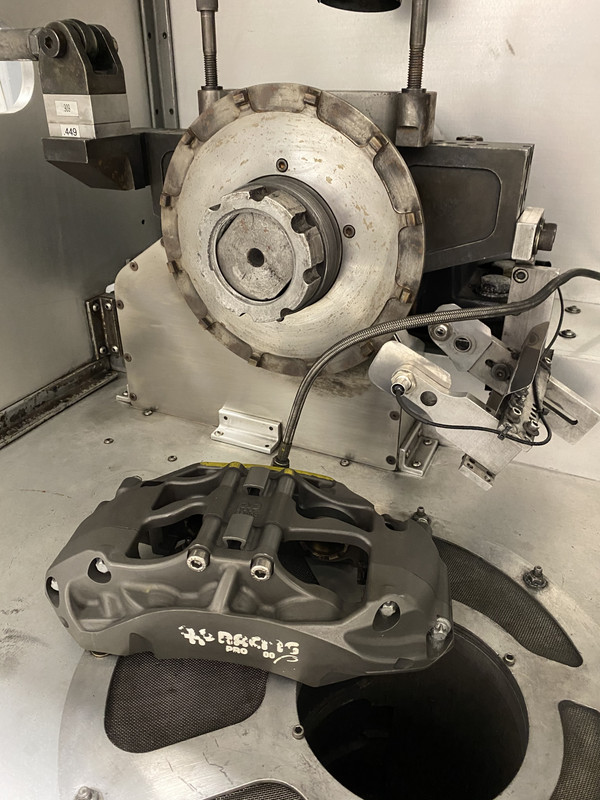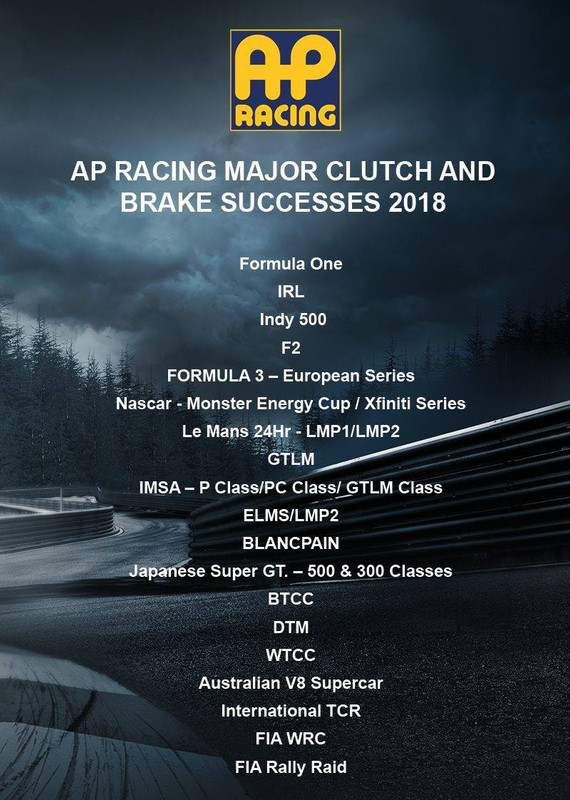We view a brake system as precisely that, a system. All the components must work together in harmony to produce the greatest result. When we design a kit, we are considering a much larger range of factors at both the system level and the component level than people typically suspect. The process is far more exhaustive than examining a simple spreadsheet or recipe of numbers. For example, when we design a component or decide upon a disc to use for a particular vehicle, our team does not sit down at a table and say, “Let’s use a 380mm disc and a red four piston caliper. Okay, we’re done here.”

Our discussions are more along the lines of considering disc diameter, disc wall thickness, air gap, flange thickness, number of mounting points, number of internal vanes, shape of the internal vanes, radial depth, pad location relative to the disc hat, disc hat offset, moving the centerline of the disc to allow wheel spoke clearance or not hitting suspension arms, etc. With calipers and adapter brackets we’re looking at pad volume, pad surface area, pad thickness, caliper stiffness, caliper cooling, potential interaction with brake ducts, wheel spoke clearance, pad location on the disc, piston sizes, piston material and ventilation, anti-knockback spring weight, bracket shape and stress points, bracket weight, size of the bracket studs, etc.
We also have a brake dynamometer at our facility, on which we do a great deal of testing. We test our own products incessantly, replicating specific racetrack simulations. We test with brake pad manufacturers. We test with professional race teams from IMSA, IndyCar, and NASCAR Cup. Below is a pic I just snapped of the same CP9660 Radi-CAL we use in our e90 M3 brake kits, that is currently bolted up to our dyno and is being intentionally beaten to hell and back.

We also test at the racetrack. We recently installed our Pro5000 Radi-CAL system on a client’s C8 Corvette and took it to Road Atlanta with a retired pro driver. We collected and analyzed a large volume of data at the track. You can see some of the video captured during those days below.
We also look specifically at how our customers are using their cars. For some chassis, we have an array of brake kits of different sizes and configurations based on how the owner is using their car. What is optimum for a daily driver certainly isn’t optimum for endurance racing. Will a sub-par brake integration using a mish-mash of components technically bolt onto a car? Possibly. Will it suck at the tail-end of a 3 hour race, very likely yes. Even if ‘the numbers’ line up on paper (piston sizes, effective radius, etc.), that doesn’t come close to ensuring the desired performance or repeatability.
Something else we try to do as well as possible is listen to our customers. Our e90 brake kit range is a great example. When we launched our first system for this chassis, the front solution used a 355x32mm disc. That system was out for a couple years, had many thousands of track laps, including The 25 Hours of Thunderhill. After discussing that system with several customers/teams, we decided to increase the front disc size when we released our new Radi-CAL system from 355x32mm to 372x34mm, and we also added more internal vanes (from 72 to 84). What we were hearing was that our customers believed the tradeoff of a little more unsprung weight (4 lbs.) was worth the additional durability the 372mm discs would provide. Since our system with the larger 372mm discs is still lighter than the OEM system by 10 lbs. nothing was lost except unsprung weight! What was gained however, was considerable disc longevity, pads running cooler, caliper running cooler, etc. They asked for it, so we gave them what they wanted.
Over time, we also see some chassis develop into new areas that place greater demands on the brakes. This is particularly true of newer vehicle releases. When a vehicle is first released it has a performance envelope limited by the total available upgrades for that platform. Over time however, upgrades come into play that make the platform considerably faster, and potentially much harder on brakes. By three years in, the performance envelope of a given chassis may be far higher than it was upon release. As noted in the video in my previous post, we try to take that into account. Sometimes however, we must adjust and adapt as real-world data comes in from the field, and the resulting decisions are based on analysis and experience.
Essex has been in business since 1981, and AP Racing has been around considerably longer. AP has more engineers than any other type of employee short of product assembly, and we have our own internal engineering team (including an AP Racing engineer on staff). We have 24 employees that do almost nothing but design, build, and service brakes all day (we do a tiny bit of wheels, heat barrier products, etc., but almost exclusively brakes). Most of our staff have decades of experience in brakes and racing.
Our engineering director is widely regarded as one of the foremost experts on brake and clutch systems. He was the technical director at Tilton for over a decade before joining Essex over a decade ago. He is frequently the chief design judge for Formula SAE, and he has likely forgotten more about brakes than anyone on this forum has ever known. He is the guy to whom you hand two pieces of twine, a toothpick, and some bubble gum, and he builds you a weapon.

AP Racing’s staff is also loaded with brilliant engineers who have been there for 4-5 decades in some cases. The AP engineer who works out of our office has been with AP for over 40 years!
We also pride ourselves on service, which is an important factor when considering a brake system. We have a trained staff on hand available by phone, chat, and email. Our customers call us all the time with questions ranging from incredibly mundane to exceedingly technical, and we are there answer them all. We’re also long-time Bimmerpost forum sponsors, and we spend a good deal of our time posting here to help people with their brake issues (in many cases when they aren’t even related to the products we offer).
Spares are also an important part of the picture. We hold hundreds of sets of spare discs and pads on-hand in our warehouse. It’s not uncommon to be prepping your car for the track on a Thursday, only to find an inner pad is worn a lot further than you expected. When that happens, you want to grab the phone, talk to a live human, get expert advice, and have a replacement on the way asap so you don’t miss the track day for which you’ve already paid. That’s what our customers receive as part of our package. What you don’t want is to and track down six different suppliers, pray that someone has what you need in stock, or deal with some guy sitting in his mom’s basement on the other side of the world.
Without all the intense design consideration, testing, and real-world feedback, analyzed by experienced experts, a brake kit is nothing more than a hodgepodge of random metal bits. When was the last time Le Mans was won by taking the calipers from a Subaru STI and bolting them to a Corvette? Never. When was the last time Le Mans was won by a well-considered, explicitly designed AP Racing brake system tailored to that specific vehicle? Last year…and the year before that, and the year before that, and so on. AP Racing produced the graph below a couple years back to illustrate the success they had in professional racing that year. They also
now have over 800 Formula 1 wins on their brake and clutch products!
When the above mix comes together, it can have an impact greater than the sum of the parts, and it produces an overwhelmingly positive experience. That’s what we are trying to achieve with our brake systems: to continually make our customer’s time at the track easier, more fun, and less stressful. Why is that our goal? Because just about everyone on our staff has been to the track with their own car at some point. We know how miserable it is to be wrenching, cursing, and bleeding, while covered in brake fluid. We don’t want that for our customers, and frankly wouldn’t wish that on our enemies.
Our customers are benefiting from our above commitment every weekend at the racetrack. If you look at the customer feedback on our Essex Blog, the result is championship-winning durability, longevity, feel, control, ease of servicing, ease of install, readily available spares, etc. I’m proud to say that we have an extremely high level of satisfaction among our owners, and they all feel that our systems are a good value, even if they are more expensive than the competition.
To answer your original question about piston sizing more succinctly: We do what we feel the chassis needs at the time, based on the extremely wide variety of reasons listed above. We don’t make decisions based on any one factor in isolation, and we don’t implement specific components on a given vehicle without a great deal of consideration. We certainly don't blindly follow a handful of numbers on a spreadsheet. We take a holistic approach that involves specific design decisions in numerous areas, a significant amount of testing, a long-running customer feedback loop, and a great deal of experience. Anyone is free to compare what we do and how we do it with anything else on the market, but we believe our unique approach ultimately provides the greatest value to the owner. Our rapidly growing and enthusiastic tribe of satisfied owners is the proof of concept.
Anything less than the above would be a disservice to our customers and would do nothing to separate us from the host of people we see slapping Brembo calipers from a Mercedes on their M car. Our customers are those who prefer not to leave anything to chance when hurtling towards a wall at 160 mph, and they value everything I’ve noted above. It’s why we are able to exist and keep doing what we’re doing.
I went on our blog and searched 'championship'. To be clear, Essex directly supports and services all of these teams. We do so with the same staff that designs and builds our brake systems for the e90 M3, using the same quality of components and the same design process. In no particular order:
IMSA:
https://www.essexparts.com/news-blog...asons-20142016
NASCAR Cup:
https://www.essexparts.com/news-blog...racing-radical
USTCC:
https://www.essexparts.com/news-blog...-racing-brakes
NASCAR Xfinity:
https://www.essexparts.com/news-blog...-racing-brakes
NASA Endurance:
https://www.essexparts.com/news-blog...rint-brake-kit
NASCAR Cup:
https://www.essexparts.com/news-blog...p-championship
SCCA:
https://www.essexparts.com/news-blog...regional-champ
NASA:
https://www.essexparts.com/news-blog/team-gspeed-win
NASA (first time our CP9660 Radi-CAL was ever raced)-
https://www.essexparts.com/news-blog...p-video-inside
Below is a list AP Racing published at the end of 2018 for the professional racing championships won by their brake and clutch products (I can't find my 2019 list right now).
